[English] 日本語
 Yorodumi
Yorodumi- PDB-6hk3: Crystal structure of GSK-3B in complex with pyrazine inhibitor C44 -
+ Open data
Open data
- Basic information
Basic information
| Entry | Database: PDB / ID: 6hk3 | ||||||
|---|---|---|---|---|---|---|---|
| Title | Crystal structure of GSK-3B in complex with pyrazine inhibitor C44 | ||||||
 Components Components |
| ||||||
 Keywords Keywords |  TRANSFERASE / GSK 3B / TRANSFERASE / GSK 3B /  Complex / Complex /  pyrazine / pyrazine /  inhibitor inhibitor | ||||||
| Function / homology |  Function and homology information Function and homology informationnegative regulation of glycogen (starch) synthase activity / neuron projection organization / regulation of microtubule anchoring at centrosome / negative regulation of mesenchymal stem cell differentiation / beta-catenin destruction complex disassembly / negative regulation of type B pancreatic cell development / superior temporal gyrus development / positive regulation of protein localization to cilium / negative regulation of glycogen biosynthetic process / negative regulation of dopaminergic neuron differentiation ...negative regulation of glycogen (starch) synthase activity / neuron projection organization / regulation of microtubule anchoring at centrosome / negative regulation of mesenchymal stem cell differentiation / beta-catenin destruction complex disassembly / negative regulation of type B pancreatic cell development / superior temporal gyrus development / positive regulation of protein localization to cilium / negative regulation of glycogen biosynthetic process / negative regulation of dopaminergic neuron differentiation / maintenance of cell polarity / positive regulation of protein localization to centrosome / : / positive regulation of mitochondrial outer membrane permeabilization involved in apoptotic signaling pathway / positive regulation of cilium assembly / negative regulation of protein acetylation / APC truncation mutants have impaired AXIN binding / AXIN missense mutants destabilize the destruction complex / Truncations of AMER1 destabilize the destruction complex / beta-catenin destruction complex /  tau-protein kinase / regulation of microtubule-based process / CRMPs in Sema3A signaling / regulation of protein export from nucleus / heart valve development / Beta-catenin phosphorylation cascade / Signaling by GSK3beta mutants / CTNNB1 S33 mutants aren't phosphorylated / CTNNB1 S37 mutants aren't phosphorylated / CTNNB1 S45 mutants aren't phosphorylated / CTNNB1 T41 mutants aren't phosphorylated / Maturation of nucleoprotein / cellular response to interleukin-3 / Wnt signalosome / regulation of axon extension / regulation of long-term synaptic potentiation / negative regulation of protein localization to nucleus / Disassembly of the destruction complex and recruitment of AXIN to the membrane / Maturation of nucleoprotein / AKT phosphorylates targets in the cytosol / positive regulation of cell-matrix adhesion / negative regulation of calcineurin-NFAT signaling cascade / dopamine receptor signaling pathway / regulation of dendrite morphogenesis / negative regulation of phosphoprotein phosphatase activity / tau-protein kinase / regulation of microtubule-based process / CRMPs in Sema3A signaling / regulation of protein export from nucleus / heart valve development / Beta-catenin phosphorylation cascade / Signaling by GSK3beta mutants / CTNNB1 S33 mutants aren't phosphorylated / CTNNB1 S37 mutants aren't phosphorylated / CTNNB1 S45 mutants aren't phosphorylated / CTNNB1 T41 mutants aren't phosphorylated / Maturation of nucleoprotein / cellular response to interleukin-3 / Wnt signalosome / regulation of axon extension / regulation of long-term synaptic potentiation / negative regulation of protein localization to nucleus / Disassembly of the destruction complex and recruitment of AXIN to the membrane / Maturation of nucleoprotein / AKT phosphorylates targets in the cytosol / positive regulation of cell-matrix adhesion / negative regulation of calcineurin-NFAT signaling cascade / dopamine receptor signaling pathway / regulation of dendrite morphogenesis / negative regulation of phosphoprotein phosphatase activity /  regulation of axonogenesis / establishment of cell polarity / regulation of axonogenesis / establishment of cell polarity /  tau-protein kinase activity / glycogen metabolic process / ER overload response / regulation of neuron projection development / Constitutive Signaling by AKT1 E17K in Cancer / tau-protein kinase activity / glycogen metabolic process / ER overload response / regulation of neuron projection development / Constitutive Signaling by AKT1 E17K in Cancer /  dynactin binding / protein kinase A catalytic subunit binding / dynactin binding / protein kinase A catalytic subunit binding /  NF-kappaB binding / canonical Wnt signaling pathway / Regulation of HSF1-mediated heat shock response / NF-kappaB binding / canonical Wnt signaling pathway / Regulation of HSF1-mediated heat shock response /  epithelial to mesenchymal transition / negative regulation of osteoblast differentiation / negative regulation of protein-containing complex assembly / positive regulation of autophagy / regulation of microtubule cytoskeleton organization / regulation of cellular response to heat / cellular response to retinoic acid / extrinsic apoptotic signaling pathway / negative regulation of extrinsic apoptotic signaling pathway via death domain receptors / extrinsic apoptotic signaling pathway in absence of ligand / epithelial to mesenchymal transition / negative regulation of osteoblast differentiation / negative regulation of protein-containing complex assembly / positive regulation of autophagy / regulation of microtubule cytoskeleton organization / regulation of cellular response to heat / cellular response to retinoic acid / extrinsic apoptotic signaling pathway / negative regulation of extrinsic apoptotic signaling pathway via death domain receptors / extrinsic apoptotic signaling pathway in absence of ligand /  excitatory postsynaptic potential / presynaptic modulation of chemical synaptic transmission / positive regulation of protein export from nucleus / positive regulation of protein ubiquitination / Ubiquitin-dependent degradation of Cyclin D / hippocampus development / positive regulation of protein-containing complex assembly / positive regulation of cell differentiation / GSK3B and BTRC:CUL1-mediated-degradation of NFE2L2 / peptidyl-threonine phosphorylation / Degradation of GLI2 by the proteasome / GLI3 is processed to GLI3R by the proteasome / negative regulation of canonical Wnt signaling pathway / tau protein binding / Degradation of beta-catenin by the destruction complex / B-WICH complex positively regulates rRNA expression / excitatory postsynaptic potential / presynaptic modulation of chemical synaptic transmission / positive regulation of protein export from nucleus / positive regulation of protein ubiquitination / Ubiquitin-dependent degradation of Cyclin D / hippocampus development / positive regulation of protein-containing complex assembly / positive regulation of cell differentiation / GSK3B and BTRC:CUL1-mediated-degradation of NFE2L2 / peptidyl-threonine phosphorylation / Degradation of GLI2 by the proteasome / GLI3 is processed to GLI3R by the proteasome / negative regulation of canonical Wnt signaling pathway / tau protein binding / Degradation of beta-catenin by the destruction complex / B-WICH complex positively regulates rRNA expression /  regulation of circadian rhythm / regulation of circadian rhythm /  beta-catenin binding / positive regulation of GTPase activity / beta-catenin binding / positive regulation of GTPase activity /  circadian rhythm / positive regulation of protein catabolic process / cellular response to amyloid-beta / neuron projection development / Regulation of RUNX2 expression and activity / positive regulation of proteasomal ubiquitin-dependent protein catabolic process / circadian rhythm / positive regulation of protein catabolic process / cellular response to amyloid-beta / neuron projection development / Regulation of RUNX2 expression and activity / positive regulation of proteasomal ubiquitin-dependent protein catabolic process /  p53 binding / presynapse / insulin receptor signaling pathway / positive regulation of protein binding / p53 binding / presynapse / insulin receptor signaling pathway / positive regulation of protein binding /  kinase activity / postsynapse / proteasome-mediated ubiquitin-dependent protein catabolic process / peptidyl-serine phosphorylation kinase activity / postsynapse / proteasome-mediated ubiquitin-dependent protein catabolic process / peptidyl-serine phosphorylationSimilarity search - Function | ||||||
| Biological species |   Homo sapiens (human) Homo sapiens (human) | ||||||
| Method |  X-RAY DIFFRACTION / X-RAY DIFFRACTION /  SYNCHROTRON / SYNCHROTRON /  MOLECULAR REPLACEMENT / Resolution: 2.35 Å MOLECULAR REPLACEMENT / Resolution: 2.35 Å | ||||||
 Authors Authors | Piretti, V. / Giabbai, B. / Demitri, N. / Di Martino, R. / Tripathi, S.K. / Gobbo, D. / Decherchi, S. / Storici, P. / Girotto, S. / Cavalli, A. | ||||||
 Citation Citation |  Journal: J Chem Theory Comput / Year: 2019 Journal: J Chem Theory Comput / Year: 2019Title: Investigating Drug-Target Residence Time in Kinases through Enhanced Sampling Simulations. Authors: Gobbo, D. / Piretti, V. / Di Martino, R.M.C. / Tripathi, S.K. / Giabbai, B. / Storici, P. / Demitri, N. / Girotto, S. / Decherchi, S. / Cavalli, A. | ||||||
| History |
|
- Structure visualization
Structure visualization
| Structure viewer | Molecule:  Molmil Molmil Jmol/JSmol Jmol/JSmol |
|---|
- Downloads & links
Downloads & links
- Download
Download
| PDBx/mmCIF format |  6hk3.cif.gz 6hk3.cif.gz | 161.8 KB | Display |  PDBx/mmCIF format PDBx/mmCIF format |
|---|---|---|---|---|
| PDB format |  pdb6hk3.ent.gz pdb6hk3.ent.gz | 126.1 KB | Display |  PDB format PDB format |
| PDBx/mmJSON format |  6hk3.json.gz 6hk3.json.gz | Tree view |  PDBx/mmJSON format PDBx/mmJSON format | |
| Others |  Other downloads Other downloads |
-Validation report
| Arichive directory |  https://data.pdbj.org/pub/pdb/validation_reports/hk/6hk3 https://data.pdbj.org/pub/pdb/validation_reports/hk/6hk3 ftp://data.pdbj.org/pub/pdb/validation_reports/hk/6hk3 ftp://data.pdbj.org/pub/pdb/validation_reports/hk/6hk3 | HTTPS FTP |
|---|
-Related structure data
| Related structure data |  6hk4C  6hk7C  4acdS S: Starting model for refinement C: citing same article ( |
|---|---|
| Similar structure data |
- Links
Links
- Assembly
Assembly
| Deposited unit | 
| ||||||||
|---|---|---|---|---|---|---|---|---|---|
| 1 | 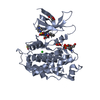
| ||||||||
| 2 | 
| ||||||||
| Unit cell |
|
- Components
Components
-Protein / Protein/peptide , 2 types, 3 molecules ABN
| #1: Protein |  / GSK-3 beta / Serine/threonine-protein kinase GSK3B / GSK-3 beta / Serine/threonine-protein kinase GSK3BMass: 39882.773 Da / Num. of mol.: 2 Source method: isolated from a genetically manipulated source Source: (gene. exp.)   Homo sapiens (human) / Gene: GSK3B / Production host: Homo sapiens (human) / Gene: GSK3B / Production host:   Trichoplusia ni (cabbage looper) Trichoplusia ni (cabbage looper)References: UniProt: P49841,  tau-protein kinase, tau-protein kinase,  non-specific serine/threonine protein kinase non-specific serine/threonine protein kinase#2: Protein/peptide | | Mass: 909.931 Da / Num. of mol.: 1 Source method: isolated from a genetically manipulated source Source: (gene. exp.)   Homo sapiens (human) / Production host: Homo sapiens (human) / Production host:   Trichoplusia ni (cabbage looper) Trichoplusia ni (cabbage looper) |
|---|
-Non-polymers , 6 types, 200 molecules 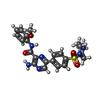
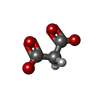


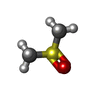






| #3: Chemical | | #4: Chemical |  Malonic acid Malonic acid#5: Chemical | ChemComp-GOL /  Glycerol Glycerol#6: Chemical |  Chloride Chloride#7: Chemical |  Dimethyl sulfoxide Dimethyl sulfoxide#8: Water | ChemComp-HOH / |  Water Water |
|---|
-Experimental details
-Experiment
| Experiment | Method:  X-RAY DIFFRACTION / Number of used crystals: 1 X-RAY DIFFRACTION / Number of used crystals: 1 |
|---|
- Sample preparation
Sample preparation
| Crystal | Density Matthews: 3.44 Å3/Da / Density % sol: 64.21 % |
|---|---|
Crystal grow | Temperature: 293 K / Method: vapor diffusion, sitting drop / pH: 7.4 / Details: 0.2M potassium fluoride 22% PEG 3350 |
-Data collection
| Diffraction | Mean temperature: 100 K | ||||||||||||||||||||||||||||||
|---|---|---|---|---|---|---|---|---|---|---|---|---|---|---|---|---|---|---|---|---|---|---|---|---|---|---|---|---|---|---|---|
| Diffraction source | Source:  SYNCHROTRON / Site: SYNCHROTRON / Site:  ELETTRA ELETTRA  / Beamline: 5.2R / Wavelength: 1 Å / Beamline: 5.2R / Wavelength: 1 Å | ||||||||||||||||||||||||||||||
| Detector | Type: DECTRIS PILATUS 2M / Detector: PIXEL / Date: Mar 20, 2018 | ||||||||||||||||||||||||||||||
| Radiation | Protocol: SINGLE WAVELENGTH / Monochromatic (M) / Laue (L): M / Scattering type: x-ray | ||||||||||||||||||||||||||||||
| Radiation wavelength | Wavelength : 1 Å / Relative weight: 1 : 1 Å / Relative weight: 1 | ||||||||||||||||||||||||||||||
| Reflection | Resolution: 2.3→46.22 Å / Num. obs: 46585 / % possible obs: 97.1 % / Redundancy: 2.4 % / CC1/2: 0.994 / Rmerge(I) obs: 0.098 / Rpim(I) all: 0.077 / Rrim(I) all: 0.125 / Net I/σ(I): 5.2 / Num. measured all: 113743 / Scaling rejects: 2 | ||||||||||||||||||||||||||||||
| Reflection shell | Diffraction-ID: 1
|
- Processing
Processing
| Software |
| ||||||||||||||||||||||||
|---|---|---|---|---|---|---|---|---|---|---|---|---|---|---|---|---|---|---|---|---|---|---|---|---|---|
| Refinement | Method to determine structure : :  MOLECULAR REPLACEMENT MOLECULAR REPLACEMENTStarting model: 4ACD Resolution: 2.35→42.977 Å / SU ML: 0.35 / Cross valid method: THROUGHOUT / σ(F): 1.96 / Phase error: 26.45 / Stereochemistry target values: ML
| ||||||||||||||||||||||||
| Solvent computation | Shrinkage radii: 0.9 Å / VDW probe radii: 1.11 Å / Solvent model: FLAT BULK SOLVENT MODEL | ||||||||||||||||||||||||
| Displacement parameters | Biso max: 136.69 Å2 / Biso mean: 56.4885 Å2 / Biso min: 18.99 Å2 | ||||||||||||||||||||||||
| Refinement step | Cycle: final / Resolution: 2.35→42.977 Å
|
 Movie
Movie Controller
Controller



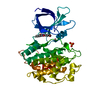


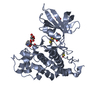

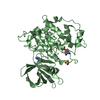
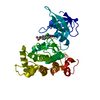

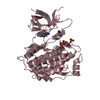
 PDBj
PDBj











